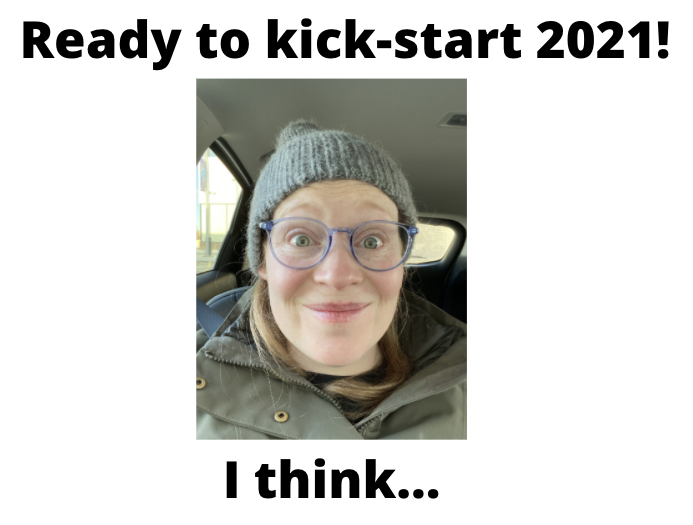Taking away positives from “emergency teaching”
Well folks, September to December has been one of the most “interesting” semesters I have taught in post-secondary education. My friends and colleagues teaching K-12 and in PETE programs across the country have also confirmed that I am not the only one feeling this way: slightly confused and shocked the semester is over, filled with self-doubt about what happened over the last several months, and very nervous about the teaching evaluations coming my way (although I have received some informal notes from students that are very positive, so thank you all for being adaptable and open to remote learning!). With all of these feelings though, I am really trying to look on the bright side as I plan and teach my course this January 2021.
My colleague (Dr. Lauren Sulz) and I were approached recently to be on a podcast with the amazing Centre for Teaching and Learning (CTL) at the University of Alberta (sidebar: CTL has been cornerstone in supporting instructors and professors throughout the transition to remote teaching – Thank you!). They have started the Teaching+ podcast that dives into issues facing post-secondary instructors. In this particular podcast we focused on teaching remotely, alongside Ellen Watson (Senior Educational Developer) and Jordan Long (Instructional Designer) and discussed the impact of “emergency” online teaching for courses that centre on a physically interactive environment, like physical education. Doing this podcast encouraged me to unpack the challenges I had faced and in turn, gave me an opportunity to reflect on the 2020 Fall term and teaching physical education online.
Teaching physical education online (by choice or not by choice…) at any phase of education (K-12, pre-service education, etc.) is not an easy feat for anyone (if it is/has been for you… please contact us and let us know HOW, WHY, and WHAT YOU DID!). But as we continue to navigate these murky waters as we continue remote delivery online this winter term, we should focus on the good that has come from this complex experience. What follows are three of my positive take-aways in preparation for what I can only anticipate will be another “interesting” ride. Hopefully after round 2 I can share some more key learnings and strategies with you all (Part 2 TBA – wish me luck!).
1. Embracing creative pedagogy: Online teaching isn’t just a replication of what you would do in your face-to-face class through a synchronous Zoom lesson. Online teaching has opened me up to explore different ways to share content in both synchronous and asynchronous ways. When choosing the method of instruction you’ll want to consider some key factors, but whether its synchronous or asynchronous take the opportunity to try out and explore the plethora of online pedagogical tools at our finger tips. How do I do this? Well first, don’t feel like you have to go crazy and revamp the wheel by using 10 new tools. Give yourself a goal of 2 new tools/activities. Navigate and try out new tools one evening and see what works for you and will engage your students in deeper learning in this remote setting.
For instance, I tried out ‘Google Jamboards’ that Dr. Jerine Pegg introduced to me at a department council meeting this year. My students contributed to a Jamboard by sharing photos and information about ‘managing the learning environment. I also created and had my students create GiFs of fundamental movement skills (idea from Sherry Holloway – who is a champ!). Both were a hit!
2. Focusing on the whole-child learning and a holistic PE program: Teaching online has given me the opportunity to highlight how PE is more than just the “physical” and it’s really about teaching the whole-child. In this approach and philosophy, teachers must understand that “students are not one-dimensional” (Gleddie, Hickson & Bradford, 2018, p. 40) and we teach with the understanding that the physical, cognitive, and affective domains are all connected and need to be accounted for in our teaching (Noddings, 2005). By focusing on all 3 domains, I have noticed that pre-service teachers start to see the curriculum in a different way and begin to get more creative with diverse activities in lesson planning and ideas to create more developmentally appropriate lessons that encompass all 3 domains. Teaching online has certainly changed the types of activities I have been able to model, but it has also allowed me to focus specifically on activities that reach students’ holistic development – moving beyond the physical and also experiencing diverse physical activities… How did I do this? Well, I used multiple strategies throughout the term: First, I started small by tapping into students’ affective domain through wellness check-ins, which was great for me to see how they were doing but it also gave them ideas for how they can do this in their future teaching. For instance, I would share the following photos,

then ask students which photo represented their feeling at that moment in time (this activity was shared with me at the PHE Canada PHETE working group sessions 2020 – I think it was Carolyn Temertzoglou! But whoever it was – thank you!). Additionally, COVID has limited our ability to use a lot of equipment and to have large group activities. This has given me the opportunity to highlight individual activities and explore alternative environments. My students engaged with much more independent exploration this term. From “solo time” in alternative environments (Thanks Dr. Shannon Kell!), which tapped into their affective domain by reflecting on this experience, to learning how to teach juggling to children, which tapped into the cognitive domain, truly showed them how teaching physical education is much more than team sports and physical fitness.
3. Emphasizing resources: From my experience, in teacher education we need to balance theory and evidence-based practices to inform our pedagogy as well as provide tangible and practical strategies, materials, etc. to support learning. I am still trying to find that balance, but from my own research I know the value and importance of practical resources for teachers as it provides them with a starting place to enhance their professional development and growth (Morrison, 2014). Teaching online has given me the opportunity to share more but also strategic resources with students. How did I do this? I wanted to go beyond throwing a bunch of websites at my students and overwhelming them with content so I would embed YouTube videos or introduce organizations within lecture materials (e.g., there are some awesome teacher-leaders/health champions YouTube sites from local, national, and international demographics (see Back to School COVID Style blog post for some ideas!). I would also share stories from my awesome colleagues (e.g., Jodi Harding-Kuriger has given me some amazing ideas for Instant Activities (see examples of here) in my class so when doing an activity I would also share that she is currently the HPEC president – this way I introduced them to Jodi AND HPEC at the same time!). Another example of embedding resources into a pedagogical strategy is having students do a “jig-saw” where they are responsible to become an expert on a website and then they share that with their group and learn from classmates about multiple different sites. The last example I will share is from Doug Gleddie and the idea of “Websites of the Week” (known to my students as WOW!) where each week I share some websites that will help their learning and professional development. I also added in my own twist with “Words of Wisdom” that go alongside the websites to try to give them a glimpse into who I am and share some insights from my teaching experiences.
 Remember, you’re not alone. Teaching PE online is not ideal (well at least Lauren and I don’t think so…) but teachers out there are doing some amazing things! My twitter feed brings me joy at the end of the day when you post a video of your class or share your challenges and I see positive feedback – so keep supporting each other and sharing. Take it one class at a time and set small goals for yourself.
Remember, you’re not alone. Teaching PE online is not ideal (well at least Lauren and I don’t think so…) but teachers out there are doing some amazing things! My twitter feed brings me joy at the end of the day when you post a video of your class or share your challenges and I see positive feedback – so keep supporting each other and sharing. Take it one class at a time and set small goals for yourself.

My 2021 goals for teaching:
- A meme a week provides a smile to the cheek
- Do lots of DPA and show them it’s fun to play
- Focus on the joy of movement and with time you’ll see planning and assessment improvement
References
Centre for Teaching and Learning (2020). Teaching Materials, Best Practices and Templates. University of Alberta. Retrieved from: https://www.ualberta.ca/centre-for-teaching-and-learning/teaching-support/learning-environments/remote-teaching/preparation/teaching-materials.html
Centre for Teaching and Learning (2020). Teaching Remotely Series: Podcast. University of Alberta. Retrieved from: https://www.podomatic.com/podcasts/teachingplus/episodes/2020-12-09T14_33_17-08_00
Centre for Teaching and Learning (2021). Synchronous and Asynchronous Learning. University of Alberta. Retreived from: https://www.ualberta.ca/centre-for-teaching-and-learning/teaching-support/learning-environments/remote-teaching/implementation/synchronous-asynchronous.html
Dr. Evil air quotes photo (2021). Retrieved from: https://knowyourmeme.com/memes/dr-evil-air-quotes
Flynn, A., & Kerr, J. (2020). Remote teaching: a practical guide with tools, tips, and techniques. Retrieved from: https://ecampusontario.pressbooks.pub/remotecourse/
Gleddie, D.L., Hickson, C., & Bradford, B. (2018). Physical education for elementary school teachers: Foundations of a physical literacy journey. Victoria: Ripon Publishing.
Kell, S. (2019). Practising solo time: Why and how. Runner: The Journal of the Health and Physical Education Council of The Alberta Teachers’ Association, 50(1), 9-11. Retreived from: http://www.hpec.ab.ca/uploads/files/RunnerVol50No1.pdf
Morrison, H. (2014). Finding and implementing relevant resources in adapted physical activity: It’s easier said than done… Brock University, St. Catharines, Ontario. Retrieved from: http://dr.library.brocku.ca/handle/10464/5405
Strategies Links:
GIFs: https://giphy.com/
Jamboard Help: https://support.google.com/jamboard/#topic=7383643
Jigsaw: https://itali.uq.edu.au/files/3077/Resources-teaching-methods-jigsawtechnique.pdf
Instant Activities: https://itali.uq.edu.au/files/3077/Resources-teaching-methods-jigsawtechnique.pdf


